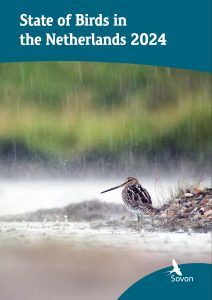
State of Birds in the Netherlands 2024
February 7, 2025 | alena.klvanova
Sovon Dutch Centre for Field Ornithology recently published its annual State of Birds. In this report, the most important current developments are listed in concise items, compiling knowledge and trends of 200 breeding and 204 migratory and wintering bird species. This information is based on data collected by volunteers throughout the country.
Download the publication
In the 2024 edition, a regular overview of species trends is provided, and the most notable developments and their possible causes are discussed. Trends, however, do not always show whether a bird population is sustainable. Representing the sustainability of a species, the Conservation Status (CS) is an important concept in nature policy and bird conservation. In the State of Birds, a reconstruction is provided for breeding and non-breeding bird species. Trends per habitat are also provided, with a particular focus on forest birds.
Changes in populations may be driven, for example, by climate change. There is a link between spring temperature and egg-laying. Data from fifteen species show that the date on which these birds start laying eggs has advanced. This link seems to depend on food sources: it is present in insectivorous birds, but this relation is not found in birds of prey (for example).
Spring 2024 was the wettest and warmest spring since the meteorological measurements in the Netherlands began. This has affected the distribution and reproduction of several species: the wet circumstances provided unexpecting breeding opportunities for Greylag Geese, while hypothermia in chicks and reduced food supply by reduced insect activity negatively affected the survival rate of species such as the Black-tailed Godwit. Some effects were more indirect: less recreation and predation led to a more successful reproduction of Common Cranes compared to previous years. Providing insight into pressure factors is also an important merit of the Dutch National Dashboard for Biodiversity, which was launched this year; an initiative in which Sovon is collaborating with IUCN NL, Naturalis Biodiversity Center and SoortenNL. The dashboard not only provides highly accessible insights into the state of biodiversity but also explains underlying pressure factors and estimates future perspectives of all native bird species.
Overall, the State of Birds 2024 demonstrates that birds remain important indicators of our interaction with nature.
Read more: https://pub.sovon.nl/pub/publicatie/22299

